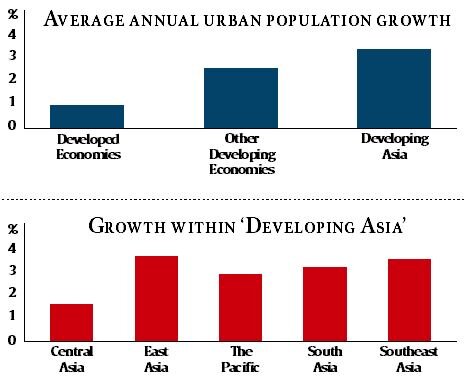Global Urbanization Shift | 01 Oct 2019
According to the economic outlook of Asian Development Outlook Report-2019, the number of urban inhabitants in developing Asia has increased almost five times since 1970.
- Asian Development Outlook Report is released by the Asian Development Bank (ADB).
- It used the data from the World Urbanization Prospects report that is released by the Department of Economic and Social Affairs of the United Nations.
Key Findings
- Between 1970 to 2017, the urban population in Developing Asia group of countries grew from 375 million to 1.84 billion. The global increase in urban population led by this region accounted for approx. 53%.
- Two-thirds of the nearly 1.5.billion additional city dwellers in Developing Asia belong to India and China.
- Developing Asia refers to a group of 45 countries that are members of the ADB.
- According to the report, the Developing Asia group urbanized faster than the rest of the world not only in terms of absolute growth but also in terms of the growth rate.
- The urban population in this region increased at an average 3.4% per annum from 1970 to 2017.
- This was much faster than the 2.6% in the rest of the developing world (mainly Africa and Latin America) and 1.0% in the developed world.
- The recent trend in Urbanisation, according to World Urbanization Prospects Report-2018:
- Urban growth is closely related to the three dimensions of sustainable development: social, economic, and environmental.
- To ensure that the benefits of urbanization are shared and that no one is left behind, policies to manage urban growth need to ensure access to infrastructure and social services for all, focusing on the needs of the urban poor and other vulnerable groups for housing, education, health care, decent work and a safe environment.
- Globally, more people live in urban areas than in rural areas, with 55% of the world’s population residing in urban areas in 2018.
- India, China, and Nigeria are expected to account for 35% of the growth in the world’s urban population between 2018 and 2050. India is projected to add 416 million urban dwellers, China 255 million and Nigeria 189 million.
- Tokyo is the world’s largest city with an agglomeration of 37 million inhabitants, followed by Delhi with 29 million, Shanghai with 26 million, and Mexico City and São Paulo, each with around 22 million inhabitants. Cairo, Mumbai, Beijing and Dhaka all have close to 20 million inhabitants.
Asian Development Bank (ADB)
- The Asian Development Bank (ADB) is a regional development bank that aims to promote social and economic development in Asia.
- It was established in December 1966 and is headquartered in Manila, Philippines.
- Japan holds the largest proportion of shares in ADB followed by the USA.

